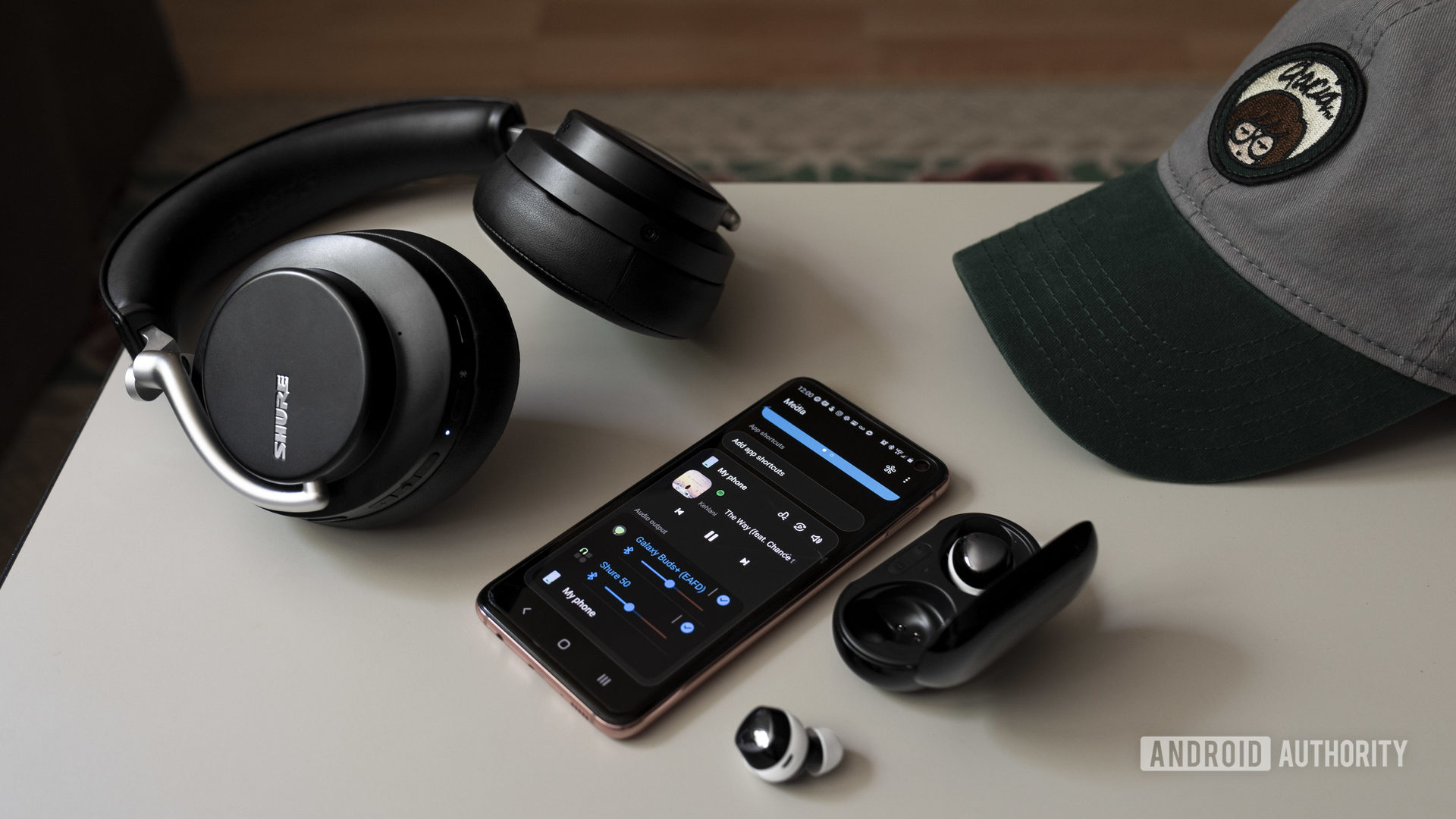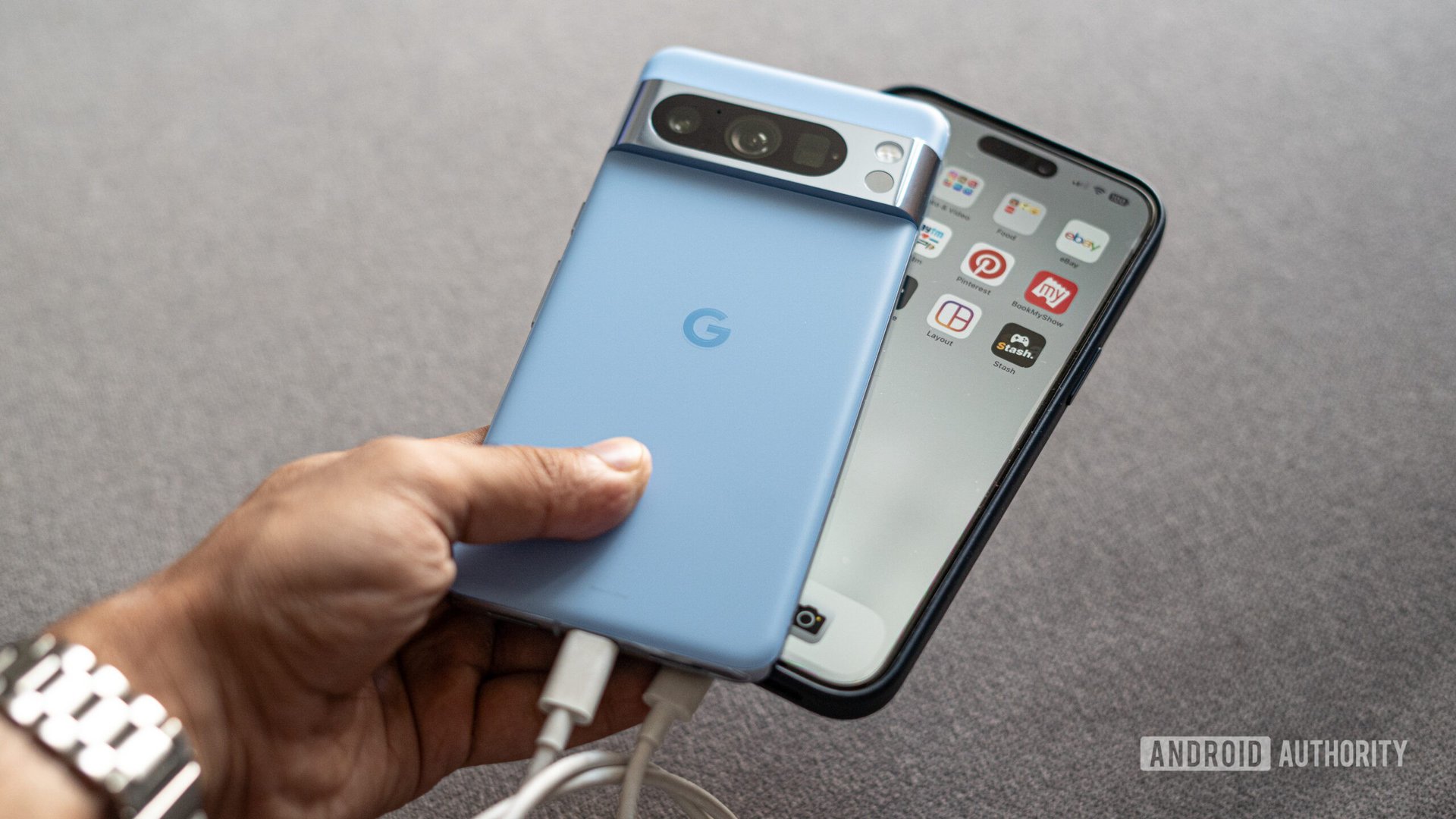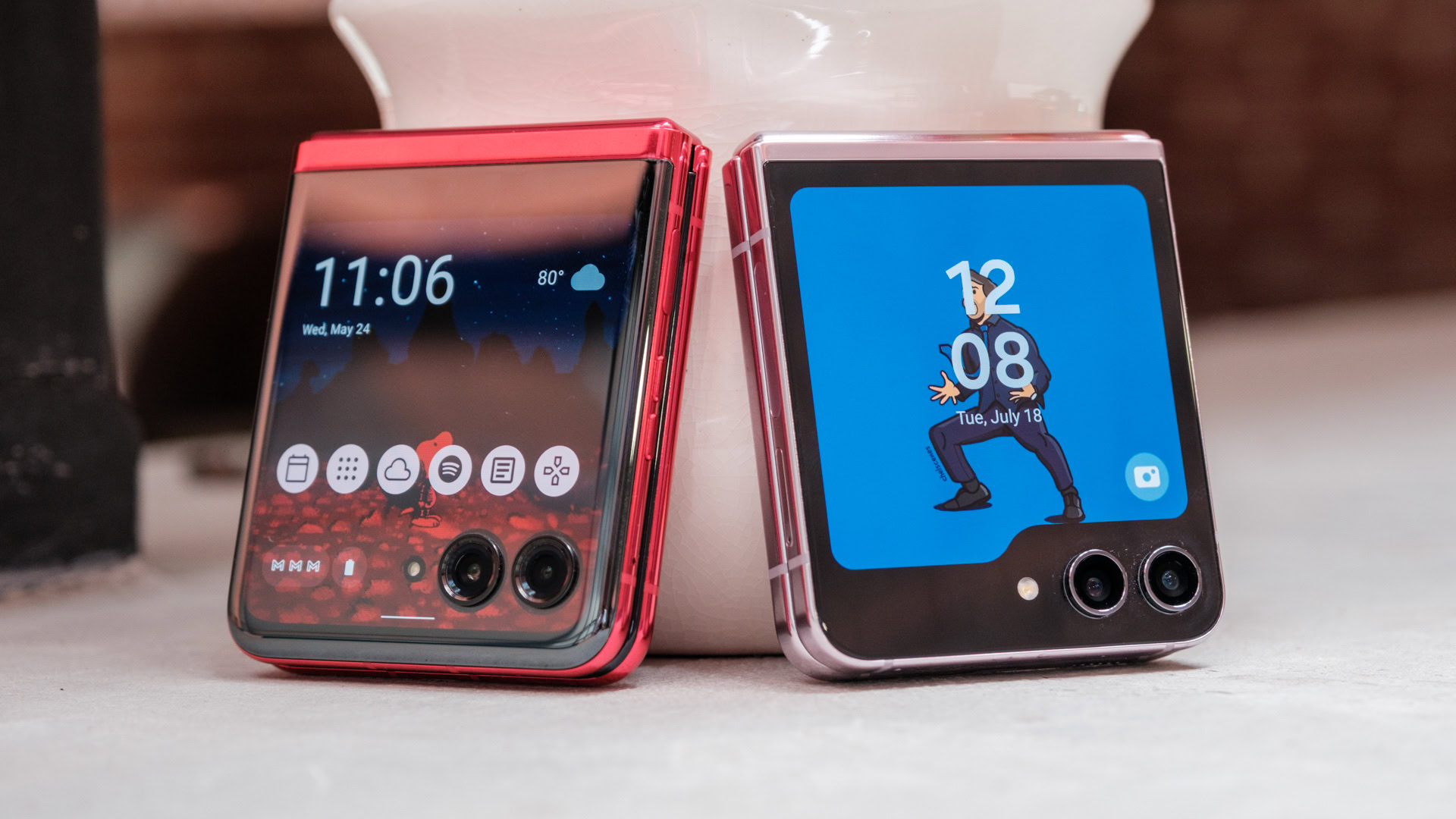Affiliate links on Android Authority may earn us a commission. Learn more.
Samsung Dual Audio: What it is and how to use it
Sharing music can be a great experience, but no one wants to use a friend’s unkempt earbuds. Samsung Dual Audio Bluetooth lets users share audio from a single Samsung device to two wireless headsets, be that Samsung Galaxy Buds, Google Pixel Buds, Apple AirPods, or others. Now it’s time to break down how to set up Dual Audio and discuss its benefits.
QUICK ANSWER
Samsung Dual Audio lets you use any Samsung Galaxy smartphone that supports Bluetooth 5.0 or later to cast audio to two compatible Bluetooth devices simultaneously. To enable Samsung Dual Audio, you must go to Settings > Connections > Bluetooth and then select Media from the notification shade.
JUMP TO KEY SECTIONS
What is Samsung Dual Audio?

Samsung Dual Audio lets you connect two Bluetooth headphones to one Samsung device, thereby allowing two friends, siblings, or partners to share in a synchronized listening or viewing experience. This dual Bluetooth feature made its smartphone debut with the Samsung Galaxy S8 series and has remained a hushed mainstay ever since. This multi-device Bluetooth feature has been around for over a decade on Samsung devices and may be traced back to the Samsung G600 slider phone.
How to use Samsung Dual Audio with dual Bluetooth headphones
To enable Samsung’s Dual Audio feature on your device, you must first pair each device with the desired Samsung Galaxy device.
- Open your device’s Settings.
- Go to the Connections menu.
- Tap Bluetooth and turn the slider to On.
- Enter Bluetooth pairing mode from your Bluetooth headset. This often requires you to press and hold the Bluetooth headphones’ power button until an LED flashes. True wireless earbuds often require you to remove both earbuds from the case simultaneously. If your headset’s pairing process deviates from the norm, refer back to the included paperwork.
- Pull down your phone’s notification shade, and tap Media.
- Check the devices you want to use for listening. You can always disable playback on a device from the Media page at any time.
When you enable Dual Audio sharing from your Samsung smartphone, the program allows you to adjust the volume levels of each headset. This option is appreciated as you don’t want to accidentally blast your friend with a high decibel output that could potentially damage their hearing or disorient them.
What Samsung phones support Dual Audio?
The following Samsung devices support Dual Audio:
- Galaxy Note 8
- Galaxy Note 9
- Galaxy Note 10, Galaxy Note 10 Plus, and Galaxy Note 10 Plus 5G
- Galaxy Note 20 and Note 20 Ultra
- Galaxy S8 and Galaxy S8 Plus
- Galaxy S9 and Galaxy S9 Plus
- Galaxy S10e, Galaxy S10 and Galaxy S10 Plus
- Galaxy S20, Galaxy S20 Plus, and Galaxy S20 Ultra
- Galaxy S21, Galaxy S21 Plus, and Galaxy S21 Ultra
- Galaxy S22, Galaxy S22 Plus, and Galaxy S22 Ultra
- Galaxy S23, Galaxy S23 Plus, and Galaxy S23 Ultra
- Galaxy S24, Galaxy S24 Plus, and Galaxy S24 Ultra
- Galaxy Tab S4
- Galaxy Tab S6
- Galaxy Tab S7, Galaxy Tab S7 Plus
- Galaxy Tab S8, Galaxy Tab S8 Plus, and Galaxy Tab S8 Ultra
- Galaxy Tab S9, Galaxy Tab S9 Plus, Galaxy Tab S9 Ultra
- Galaxy Z Flip, Z Flip 2, Z Flip 3, Z Flip 4, and Z Flip 5
- Galaxy Z Fold 3, Galaxy Z Fold 2, Galaxy Z Fold 3, Galaxy Z Fold 4, and Galaxy Z Fold 5
Since different Bluetooth audio devices experience different transmission latency rates, Samsung doesn’t recommend using Dual Audio to output sound from speakers simultaneously.
Do non-Samsung phones have Dual Audio?

Apple devices have a feature called “share audio,” which the company introduced with iOS 13.1 and iPadOS 13.1. Share audio functions similarly to Samsung Dual Audio, so you and a friend can simultaneously stream synchronized audio from a single source. This works with any headset that houses Apple’s H1 chip or W1 chip.
Here is a comprehensive list of the compatible headphones: AirPods (1st generation), AirPods (2nd generation), AirPods (3rd generation), AirPods Pro (1st generation), Apple AirPods Pro (2nd generation), AirPods Max, Beats Fit Pro, Beats Flex, Beats Solo Pro, Beats Solo3 Wireless, Beats Studio3 Wireless, BeatsX, Beats Powerbeats, Beats Powerbeats Pro, and the Beats Powerbeats3 Wireless.
To do this, you and the other person need a few things: compatible Apple or Beats series headphones and an iPhone or iPad. After that, follow these steps for devices running iOS 15.1 and iPadOS 15.1 or later:
- Connect the compatible AirPods or Beats headset to your device.
- Tap the AirPlay icon on the Now Playing screen, Lock Screen, or from the Control Center.
- Tap “Share Audio,” which will appear below the name of your headset.
- Make sure the other person’s compatible headset is near your Apple device.
- Tap “Share Audio” on your device.
- Ask your friend to tap “Join” from their device.
If you don’t have an iPhone or Samsung device, you can still use audio sharing through something like Skullcandy’s app, which allows you to share audio to two compatible Skull-IQ headsets from a single device. This function works on iOS and Android. To keep things simple, however, you can always use a headphone splitter to share audio with a friend. Of course, this requires your smartphone to have a headphone jack, but it’s the most direct solution.
Bose also has a similar audio-sharing solution through its SimpleSync feature in the Bose Music app (iOS/Android). With this, you can stream audio to multiple wireless headphones and speakers simultaneously. I tested this out on the Bose Smart Soundbar 600 and shared audio output with my JBL Clip 4, so music played back through both speakers at the same time. SimpleSync also works when streaming from the soundbar to multiple wireless headphones and earbuds. The intention is that you and some friends can watch the same thing at different volume levels through your respective headsets, but it works just as well for music listening too.
Why don’t more handsets support dual audio functionality?

The benefit of dual audio output is clear: you can share a video or music with a friend without having to physically share a pair of earbuds, which can be unsanitary even if they’re frequently cleaned. Plus, it physically tethers you close together, which isn’t ideal. While there aren’t handsets that fully support audio sharing to the degree that Apple and Samsung do, the rollout of LE Audio and the LC3 codec will allow all Bluetooth 5.2 devices to share audio. With this, you can enjoy multi-device streaming from one source. For instance, two or more listeners will be able to stream movie audio from a single Bluetooth 5.2 tablet to multiple Bluetooth 5.2 headsets. It will take some time before this becomes ubiquitous, which could explain why so few phone manufacturers have pursued a “dual audio” function like Samsung’s.
For now, we are limited to Samsung and Apple regarding audio-sharing features. Granted, handsets released with Bluetooth 5.2 will support LE Audio down the line. If this is an important feature to you, you may want to grab the Google Pixel 7 series or Pixel 8 series, Sony Xperia 1 V, Redmi Note 13 Pro 5G, and so on. Notably, the most recent Samsung and iPhones also support Bluetooth 5.2 and will support LE Audio.
We’re excited for dual audio functionality to become more ubiquitous as it serves a purpose beyond entertainment: this is a great way to listen to the same motivational tracks while working out with a friend or to engage in a podcast together. One of my favorite things about Samsung Dual Audio is how it benefits listeners with hearing impairments.
It can be frustrating for those who are hard of hearing to watch a quick YouTube video with their children: their kids may be able to hear dialogue at low volumes, while the parent requires a much louder output. If the child is content with the volume levels, the parent may be left aggravated that they can’t hear half of what’s being said. Alternatively, if the parent is pleased with the volume output, the child may feel frustrated by how fatigued they are by the speaker’s loudness. A great way to negotiate this is by way of Samsung Dual Audio: two headsets with two varied volume levels connected to a single device.
This may seem a small thing to those of us who have undamaged hearing, but it can make a world of difference for those who are tired of missing half of a conversation or show dialogue because those around them can hear without issue.
Frequently asked questions about Samsung Dual Audio
Yes, the Samsung Dual audio Bluetooth feature has been a mainstay of Samsung products since the launch of the Samsung Galaxy S8 series. Up-to-date devices like the Samsung Galaxy S24, Galaxy Tab S9, and Galaxy Z Flip 4 all support Samsung Dual Audio.
You can access Samsung’s Dual Audio feature by pairing two Bluetooth devices to the desired Samsung Galaxy device. Then, open Settings > Connections > Bluetooth and turn the slider to On. Enter Bluetooth pairing mode on your Bluetooth headset, pull down your phone’s notification shade, and tap Media.
Samsung’s Dual Audio feature is available on Samsung Smart TVs manufactured since 2022.
Firstly, enable Bluetooth on your Samsung Galaxy smartphone by navigating to Settings > Connections > Bluetooth and turning the slider to On. Enter Bluetooth pairing mode on your Bluetooth headset, pull down your phone’s notification shade, and tap Media.
Bluetooth multipoint and Dual Audio facilitate inverse functionalities: the Bluetooth multipoint lets a single pair of wireless earbuds connect to two or more source devices at a time (e.g., smartphone and laptop), while the latter allows a single source device to send audio to two receiving headsets simultaneously.
While multi-device Bluetooth audio sharing is great, it isn’t perfect: yes, when I was testing headsets there was always a slight lag in playback from one to another. It was minimal, though (< 0.5s), and wasn’t distracting for my friend and me.
Bluetooth codec support matters when you want to reduce latency, but even when streaming over optimal high-quality Bluetooth codecs, there was a minor delay between headsets. I experimented with various combinations of the Samsung scalable codec, AAC, LDAC, and aptX and the delay was prevalent no matter what.
Yes, you can send audio from a compatible Samsung device to a pair of earbuds and a Bluetooth speaker, or dual Bluetooth speakers.
Yes, media playback will still automatically pause when one listener removes their compatible Samsung Galaxy Buds from their ears. To resume playback, the listener will have to reinsert the earbuds and tap play from the Samsung Galaxy smartphone screen or via the true wireless earbuds’ onboard touch controls.
Unfortunately, not all Android devices support a feature like Samsung Dual Audio; though, virtually all Android smartphones can connect to two devices simultaneously. For instance, the Google Pixel 4 can connect to two Bluetooth headsets simultaneously, but can only output audio to one at a time. According to Google, users must download a third-party app (e.g., Bose Connect) to output audio to multiple wireless devices.
No, Apple SharePlay is a completely different feature akin to Spotify’s “Group Session” feature. With Apple SharePlay, you and a few friends can join a FaceTime call (iOS 15.1 or later) and watch movies and TV shows, or listen to music live together.
Apple does, however, have a “Share audio” feature on its iOS and iPadOS devices that lets you and a friend listen to music simultaneously through two sets of AirPods or compatible Beats headphones.